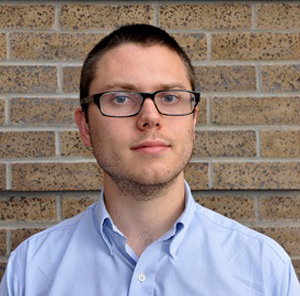At some point, Paul Gamble might have to make a decision.
Will the 25-year-old Washington University medical student pursue his dream of becoming a doctor? Or will he continue down the path of innovative entrepreneurship, after the progress he has made in creating a new medical device startup company that targets early detection of eye disorders in children?
“That’s something I think about often. I love medicine, but I’m very interested in business and entrepreneurship as well.” says Gamble.
For now, Gamble’s decision is to follow both paths – with one eye on becoming a doctor specializing in ophthalmology, neurology or neurosurgery – and the other on his new company, Visiolog.
To understand what Visiolog does, it’s important to understand the concept of visual suppression, the phenomenon in which the human brain compensates for visual disorders.
“When there’s a problem with the eye, such as an anatomical defect, a misalignment or a nerve problem, the brain will suppress or regulate information from one of the eyes,” says Gamble.
So, for example, the brain can eliminate double vision by ignoring the images of one of the eyes.
“We know visual suppression is a key, leading indicator of a visual disorder,” says Gamble. “Visual suppression begins before the disorder has really reached its full effect.”
By detecting visual suppression, a doctor or a clinician can help detect visual disorders in children as young as three or four years old – the age on which Gamble and his team are focusing.
“I work with a group of researchers, Carl Bassi, Michael Howe, and Wayne Garver, who were acutely aware that visual suppression wasn’t being assessed in a satisfactory way. They started to build a device to correct that. They were aware that my co-founder Matthew MacEwan and I had some entrepreneurial experience and so they asked us to help them commercialize the product.”
The “product” that’s soon to hit the market is a patented device that looks much like a television remote control unit. It uses an array of LED lights and sensors to detect visual suppression in children’s eyes within a minute of administering the test. Gamble says the device is more efficient than traditional tests, such as the standard eye chart, and another test, called the Worth 4 dot test, that have been used by doctors for decades.
The device has been designed to be simple enough to allow parents to use it.
Visiolog recently completed a pre-clinical trial with 200 patients – about 30 percent of them three to four years old — at Cardinal Glennon Children’s Hospital and St. Louis University Hospital, the results of which, Gamble says, were very encouraging. “The reports back were that the device was easy to use, and more importantly, it was shown to be much more effective than the Worth 4 dot test.”
Gamble says he is now identifying optometrists and chain eye clinics about employing the device.
To date, the company has amassed roughly $10,000 in angel funding and about $100,000 in additional investment, and is actively looking for additional capital.
If the dollars continue to roll in, Gamble might be provided a clearer vision in his choice between “doctor” and “entrepreneur.”




Recent Comments